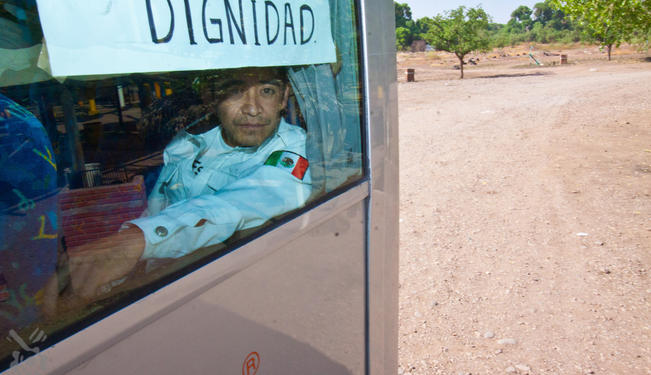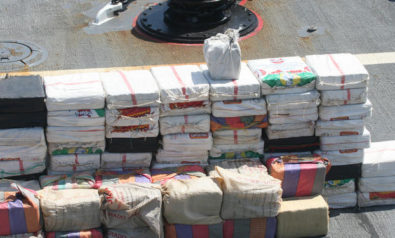Nameless and faceless, migrants traveling through Mexico inhabit the shadowy intersections of drug war violence, government corruption, and poorly designed policy.
The price of winning the drug war includes the nearly 250,000 migrants passing through Mexico each year, a factor which the incoming administration will be forced to address.
In one horrific incident on August 25, 2010, Mexican marines discovered 72 bodies at a ranch outside San Fernando, Tamaulipas—14 miles from the border with Texas. The investigation revealed that the 58 men and 14 women found were undocumented immigrants from Honduras, El Salvador, Brazil, Venezuela, and Ecuador. The sole survivor, an Ecuadorian teenager who alerted soldiers at a military checkpoint, described how Zeta gunmen intercepted the group. After a shakedown yielded little cash, the migrants were told they could work as assassins for the cartel. When they refused, the gunmen opened fire.
The Zetas-officiated massacre was categorized as one of the largest discoveries of the then 4-year-old war on drugs. Quick to report a silver lining to the slaughter, President Felipe Calderon released a statement, declaring that drug gangs were “resorting to extortion and kidnappings of migrants for their financing and also for recruitment because they [were] having a hard time obtaining resources and people.”
The San Fernando massacre revealed the consequences that ensue when new profit models become entangled in a bloody turf war between the Gulf Cartel and Los Zetas, amidst the onslaught of government forces. With a quarter million migrants journeying through Mexico to reach the United States each year, organized crime can draw from an endless supply of raw and particularly vulnerable human material primed for kidnapping, extortion, recruitment, and trafficking.
Unfortunately, the massacre would not be the last discovery of its kind. The following April, an additional 193 bodies were found dumped across 40 unmarked graves dotting the San Fernando landscape. Many of the graves were located near the highways leading to Reynosa and Matamoros – routes frequently used by migrants headed to the United States. Survivors described how bus passengers who refused to pay Zetas-authorized ‘polleros,’ or human traffickers that get migrants across borders, were picked off one by one in gruesome ways. Forensic evidence revealed that many were made to fight in gladiator-style matches against each other.
This find reaffirmed analyses of cartel business expansion into kidnapping as they scrambled to make up for profits lost from interdicted drug shipments. The involvement of polleros was also a sign of troubling statistics to come. The National Commission for Human Rights (CNDH) reported that an estimated 9,758 migrants were kidnapped between September 2008 and February 2009, or about 1,600 per month. The numbers indicated a kidnapping epidemic among transiting migrants that only got worse. By 2011, the count soared to 11,333 documented migrant kidnappings between April and September.
Today, experts believe 22,000 migrants are kidnapped each year. Many are kept in safe houses until relatives in the US pay ransoms ranging from $3,000 to $5,000. And these are just the reported figures. Despite a law that allows the concession of temporary visas to undocumented immigrants during the course of an investigation, many are afraid to report crimes in which state and federal law enforcement are often complicit. The arrests made in the wake of the First San Fernando Massacre turned up 16 police officers connected to the crime. Based on surveys conducted in migrant shelters, the same CNDH report estimated 8.9% of all migrant kidnappings in 2010 were carried out by local law enforcement. More often than not, the most common offense committed by municipal, state and federal police officers is inaction after a crime has been reported.
Marginalization, poverty, mental and physical isolation, and lack of local knowledge make those traveling northwards targets of abuse. However, for women, the dangers are always more harrowing. Many take birth control before heading north in fear that they’ll end up pregnant once they are raped; the seemingly maddening resignation of this act is realistic: sixty percent of women are sexually abused throughout the journey. Sex trafficking, an increasingly prevalent practice for organized crime and corrupt law enforcement, is a lucrative business, ranking in $1.6bn a year across Latin America and the Caribbean.
Blood and History
The drug war death toll today stands at around 50,000, and it is unclear how the incoming administration will address these issues. President-elect Enrique Peña Nieto of the Revolutionary Institution Party (PRI) pledged to focus on the protection of citizens while increasing intelligence ties with the US over the more punitive drug bust tactics used by his conservative predecessor, Felipe Calderón. Peña Nieto’s more recent activity includes the appointment of General Carlos Naranjo, former head of Colombia’s National Police and the man who helped kill Pablo Escobar, and brief mention of a comprehensive drug policy that includes legalization.
But although Mexico’s president-elect may have opened the debate on legalization, many fear that the omission of a clear plan during his three-month campaign and the attention shift to netting smaller, local gangs means that Peña Nieto will look the other way as big cartels smuggle drugs north. The incoming president will need to balance less violent, effective policy to counteract suspicions that the PRI tolerated drug trafficking throughout its 71-year reign. Moreover, the geographic and political proximity to the United States means that legalization talks are a fruitless effort when rising demand for illegal drugs stateside fuels much of the problem.
Although a pressing concern for human rights activists, the issue of migrant safety rarely came up during Peña Nieto’s campaign. Security plans drafted with the Central American nations have yet to be discussed despite the gauntlet Mexico has become for migrants. Anti-corruption enforcement, a key policy of the incoming administration, will extend to institutions like the National Institute for Migration (INM) against which activists and migrants have filed complaints for selling migrants to criminal organizations. Aside from existing underfunded and understaffed efforts, incoming administration-led proposals designed to keep migrants safe remain undrafted.
Fear, Resistance, and Memory in the Gauntlet
“Migrants in transit are among the most vulnerable people because they don’t have any type of protection,” said Xochitl Espinosa, programs and operations manager for the National Alliance of Latin American and Caribbean Communities (NALACC). “They have become the new market for criminal groups because they have relatives in the United States and they can get money from them, they can kidnap them, they can use them for any services they need.”
The need to educate people in both Latin America and in the United States on the dangers that may await them and their family members is prelavent, Espinosa commented. “Most people have no clue how bad it is, they send out for their kids because they’ve been here for 10, 15 years and think the way they did it is still safe. So on the kid’s 15th birthday they send them money to come up and they don’t realize the danger. It’s not how it works anymore.”
The Caravan for Peace with Justice and Dignity, led by Mexican poet-activist Javier Sicilia, seeks to “spark a debate led by the victims and critics of the war on drugs.” Among them are Central Americans and organizations like NALACC who stress the interconnectedness between the drug war, punitive migration laws, and human movement and displacement.
Sympathy and resources for transiting migrants exist. Government sponsored groups like Grupo Beta Sur, the National Comission for Human Rights, and non-profit organizations like the Casa del Migrante Scalabrini network and Una Mano Amiga provide assistance to migrants in the form of food, temporary shelter, educational awareness on the dangers of the road and orientation to other institutions better suited individual needs and grievances. Some activists groups, like the Movimiento Migratorio Mesoamericano, suggest plans like increasing public and interstate bus routes, and placing special law enforcement presence near railroads. Still, no word exists on whether the Peña Nieto administration will bolster funds for the national and state institutes that finance local efforts.
As we revisit San Fernando on its second anniversary and the estimated 25,000 bodies that may lie undiscovered and unclaimed underneath the desert sand, the question of anonymity and placement in the drug war remains. “Yesterday they were 6 million/ today they are more, without a name, without a face/ sons and daughters of a past where they learned/ to sing from their ashes piles,” writes Father Flor Maria Rigoni, the Italian priest running the Albergue Belen shelter, in a poem titled “Our Forgotten Shoah.” With priorities being its own citizens, a cohesive strategy, and decreasing violence, it is unclear whether the many migrants who have been kidnapped, died, or disappeared on their way North will be a consideration for the coming administration. What is evident is that Mexico’s drug war has become a regional tragedy.
Support Fair Observer
We rely on your support for our independence, diversity and quality.
For more than 10 years, Fair Observer has been free, fair and independent. No billionaire owns us, no advertisers control us. We are a reader-supported nonprofit. Unlike many other publications, we keep our content free for readers regardless of where they live or whether they can afford to pay. We have no paywalls and no ads.
In the post-truth era of fake news, echo chambers and filter bubbles, we publish a plurality of perspectives from around the world. Anyone can publish with us, but everyone goes through a rigorous editorial process. So, you get fact-checked, well-reasoned content instead of noise.
We publish 2,500+ voices from 90+ countries. We also conduct education and training programs
on subjects ranging from digital media and journalism to writing and critical thinking. This
doesn’t come cheap. Servers, editors, trainers and web developers cost
money.
Please consider supporting us on a regular basis as a recurring donor or a
sustaining member.
Will you support FO’s journalism?
We rely on your support for our independence, diversity and quality.







Comment